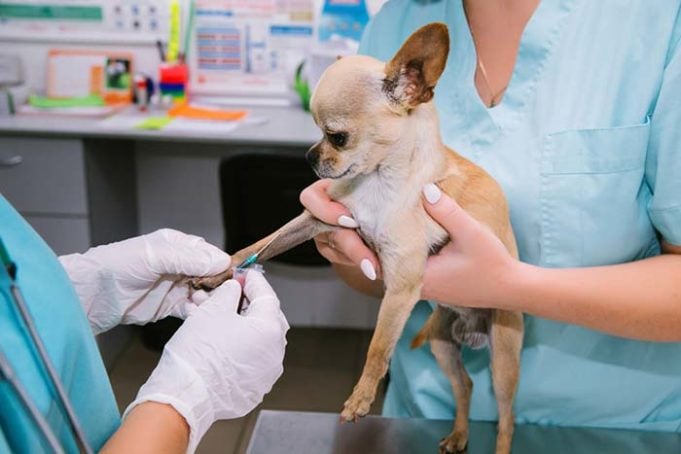Canine hypoglycemia, or low blood sugar, can happen for a variety of reasons. To understand what you should do if your dog is experiencing low blood sugar you should first understand what low blood sugar is, what causes low blood sugar in your dog, and which dogs are most at risk. After a proper diagnosis, your veterinarian will be able to help you understand what the next steps of actions are and how to help your dog should their blood sugar become low again.
What is Canine Low Blood Sugar?
Sugar is your dog’s main source of energy. If your dog is experiencing low blood sugar then their ability to properly function decreases and their energy levels will decrease, too. In extreme situations low blood sugar can cause serious health issues such as black out or even death.
When you think of low blood sugar you probably think of diabetes, but it is important to know that there are many other reasons that your dog may be experiencing low blood sugar, such as pregnancy, cancer, kidney failure, infection, or ingestion of something toxic. Keep in mind any other symptoms that your dog may be exhibiting along with the signs of low blood sugar so that your veterinarian has a better picture of what might be causing your dog to experience low blood sugar.
What are the Symptoms of Low Blood Sugar in Dogs?
The symptoms of low blood sugar as:
- Loss of appetite or an increased hunger
- Visual instability, such as blurred vision or even blindness, causing your dog to walk cautiously or bump into objects they are used to walking around
- Disorientation and confusion – your dog may show an apparent inability to complete basic routine tasks that they are used to performing
- Weakness, low energy, loss of consciousness
- Seizures, although rare
- Anxiety or restlessness
- Tremors, shivering, or uncontrollable shaking
- Heart palpitations (as noticed by your dog’s veterinarian)
- Unusual behavior
If your dog is experiencing these symptoms, or you believe that they have low blood sugar you should take them to the veterinarian if they are conscious and you do not fear that they will lose consciousness prior to getting to the veterinary clinic.
Which Dogs are Most at Risk of Having Low Blood Sugar?
The dogs that are most at risk of having low blood sugar are puppies, toy breeds, small breed dogs, and dogs who exert a lot of energy.
Puppies are most susceptible to low blood sugar because their bodies have not developed to the point where they are able to regulate their blood sugar levels on their own consistently.
Toy breeds and small breed dogs are susceptible to low blood sugar because they are often unable to store enough glucose to support their high amounts of energy. The combination of low glucose in storage accompanied with a high energy expenditure can result in a glucose deficiency, or low blood sugar.
Dogs who exert a lot of energy include dogs who may be pregnant, hunt frequently, are worker dogs (such as herding dogs), or dogs with known medical problems. If your dog is a working dog, hunts often, has known medical conditions, or may be pregnant then they may be at risk for low blood sugar.
How Does My Veterinarian Diagnose Canine Low Blood Sugar?
Low blood sugar is not a disease itself; rather, it is a symptom of an underlying disease or problem. To find out what the underlying disease or problem is, you should take your dog to the veterinarian for a proper diagnosis.
Your veterinarian will diagnose your dog by reviewing their health history and running a series of blood tests. The blood tests may include a blood chemical profile, a complete blood profile, and a complete blood count. Additionally, your veterinarian may want to run a urinalysis.
Be sure to give your dog’s complete medical history to the veterinarian, along with what they are currently eating, any recent dietary changes, the last time they were in heat (if they have not been spayed), and any medications or supplements they are on. Your veterinarian will take all of this information along with the results of the various blood tests and urinalysis to reach a complete diagnosis.
How is Canine Low Blood Sugar Treated?
If you believe your dog is experiencing low blood sugar and they are exhibiting symptoms like they might lose consciousness or have lost consciousness, call your veterinarian immediately. They will be able to offer you suggestions on how to raise your dog’s blood sugar until you can transport them to the clinic for care.
If your veterinarian gives you suggestions on how to raise your dog’s blood sugar and you believe that your dog is better do not stay home. Be sure to go in for a visit so that your veterinarian can examine your dog. Your dog may continue to experience low blood sugar and it can result in death.
How Can I Prevent My Dog From Getting Low Blood Sugar?
If you believe that your dog fits into one of the categories where they are at risk for low blood sugar, talk to your veterinarian. Monitor your dog if they fit into one of the categories and have a plan of action ready if your dog should suddenly experience the symptoms of low blood sugar.
 Prevention can happen by feeding your dog smaller meals throughout the day rather than one large meal once per day. Honey can also boost your dog’s blood sugar if it is extremely low and needs to be raised so that he or she can safely make it to the veterinarian clinic for proper examination, diagnosis, and treatment.
Prevention can happen by feeding your dog smaller meals throughout the day rather than one large meal once per day. Honey can also boost your dog’s blood sugar if it is extremely low and needs to be raised so that he or she can safely make it to the veterinarian clinic for proper examination, diagnosis, and treatment.
Remember, if your dog is exhibiting low blood sugar symptoms, the quicker you are to get your dog treatment the more likely they are to recover without any lasting effects, and the less likely they are to continue to have these problems because they have gone undiagnosed.
READ NEXT: Do Dogs Have Blood Types? (And Other Related Facts)













